#Person to Person Payment Market trends
Text
Person to Person Payment Market Next Big Thing | ClearXchange, Tencent, Square, Circle Internet Financial, Phonepe
Advance Market Analytics published a new research publication on “Global Person to Person Payment Market Insights, to 2028” with 232 pages and enriched with self-explained Tables and charts in presentable format. In the study, you will find new evolving Trends, Drivers, Restraints, Opportunities generated by targeting market-associated stakeholders. The growth of the Person to Person Payment market was mainly driven by the increasing R&D spending across the world.
Major players profiled in the study are:
PayPal Pte. Ltd (United States), Tencent (China), Square, Inc (United States), Circle Internet Financial Limited (Ireland), ClearXchange (United States), Stripe (Germany), TransferWise Ltd (United Kingdom), CurrencyFair LTD (Ireland), One97 Communications Ltd (India), Phonepe(India), MobiKwik (India)
Get Free Exclusive PDF Sample Copy of This Research @ https://www.advancemarketanalytics.com/sample-report/127398-global-person-to-person-payment-market?utm_source=OpenPR&utm_medium=Vinay
Scope of the Report of Person to Person Payment
Person to Person payments are popularly known as P2P Technology or Peer-to-Peer payment which allows the customers to pay funds, bills from their bank account to credit card to another individual (Mall, retailer, bills, tours, tickets, etc) by using mobile phone using internet service by easily installing the specific app of that company. It is an online technology that helps in secure payments. It has made easy payments for various platforms. As there is high adoption of digitization in the world the growing use of E-commerce resulting in demand for online payment services.
On 1st November 2019, Square completed the sale of Caviar to DoorDash.
On 7th February 2020, Square announced it has acquired Canadian company Dessa for its development of business. It will help in machine learning abilities for the company.
The Global Person to Person Payment Market segments and Market Data Break Down are illuminated below:
by Type (NFC/Smartcard, SMS, Mobile Apps), Application (Money transfers & Payments, Easy payments), End Users (Retail, Travels and Hospitality, Transportation and Logistics, Energy and Utilities), Purchase (Airtime transfer & Top-Ups, Merchandise & Coupons, Travel & Ticketing), Locations (Remote payments, Proximity payments)
Market Opportunities:
Growing Digital Driven Lifestyle
Growing Online Shopping And Banking Applications
Market Drivers:
Growing Acceptance Of Online Banking
Increasing No Of Digital Devices Like Smart-Phones, Mobiles Etc
Market Trend:
Growing E-Commerce Application In P2P Technology
What can be explored with the Person to Person Payment Market Study?
Gain Market Understanding
Identify Growth Opportunities
Analyze and Measure the Global Person to Person Payment Market by Identifying Investment across various Industry Verticals
Understand the Trends that will drive Future Changes in Person to Person Payment
Understand the Competitive Scenarios
Track Right Markets
Identify the Right Verticals
Region Included are: North America, Europe, Asia Pacific, Oceania, South America, Middle East & Africa
Country Level Break-Up: United States, Canada, Mexico, Brazil, Argentina, Colombia, Chile, South Africa, Nigeria, Tunisia, Morocco, Germany, United Kingdom (UK), the Netherlands, Spain, Italy, Belgium, Austria, Turkey, Russia, France, Poland, Israel, United Arab Emirates, Qatar, Saudi Arabia, China, Japan, Taiwan, South Korea, Singapore, India, Australia and New Zealand etc.
Have Any Questions Regarding Global Person to Person Payment Market Report, Ask Our Experts@ https://www.advancemarketanalytics.com/enquiry-before-buy/127398-global-person-to-person-payment-market?utm_source=OpenPR&utm_medium=Vinay
Strategic Points Covered in Table of Content of Global Person to Person Payment Market:
Chapter 1: Introduction, market driving force product Objective of Study and Research Scope the Person to Person Payment market
Chapter 2: Exclusive Summary – the basic information of the Person to Person Payment Market.
Chapter 3: Displaying the Market Dynamics- Drivers, Trends and Challenges & Opportunities of the Person to Person Payment
Chapter 4: Presenting the Person to Person Payment Market Factor Analysis, Porters Five Forces, Supply/Value Chain, PESTEL analysis, Market Entropy, Patent/Trademark Analysis.
Chapter 5: Displaying the by Type, End User and Region/Country 2017-2022
Chapter 6: Evaluating the leading manufacturers of the Person to Person Payment market which consists of its Competitive Landscape, Peer Group Analysis, BCG Matrix & Company Profile
Chapter 7: To evaluate the market by segments, by countries and by Manufacturers/Company with revenue share and sales by key countries in these various regions (2023-2028)
Chapter 8 & 9: Displaying the Appendix, Methodology and Data Source
Finally, Person to Person Payment Market is a valuable source of guidance for individuals and companies.
Read Detailed Index of full Research Study at @ https://www.advancemarketanalytics.com/buy-now?format=1&report=127398?utm_source=OpenPR&utm_medium=Vinay
Thanks for reading this article; you can also get individual chapter wise section or region wise report version like North America, Middle East, Africa, Europe or LATAM, Southeast Asia.
Contact Us:
Craig Francis (PR & Marketing Manager)
AMA Research & Media LLP
Unit No. 429, Parsonage Road Edison, NJ
New Jersey USA – 08837
#PersontoPersonPayment
#PersontoPersonPaymentMarket
#PersontoPersonPaymentMarketgrowth
#PersontoPersonPaymentMarketSize #PersontoPersonPaymentMarketTrends
#Person to Person Payment market analysis#Person to Person Payment Market forecast#Person to Person Payment Market growth#Person to Person Payment Market Opportunity#Person to Person Payment Market share#Person to Person Payment Market trends
0 notes
Text
Tackling abbreviations in Chinese (简称)

Let's learn some abbreviations 简称! A common format you may encounter is ABCD -> AC. AB is one word, CD is another word, and the two can be abbreviated as AC. As a learner, these can be a bit tricky to figure out the first time, but I find that they're usually pretty easy to remember if you know both constituent words.
(1) 家庭教师 -> 家教
家教 jiājiào - private tutor
家庭 jiātíng - family / household
教师 | 教師 jiàoshī - teacher
I mentioned 家教 in this recent post: Do you really know the meaning of a word?
(2) 环境保护 -> 环保
环保 | 環保 huánbǎo - environmental protection / environmentally friendly
环境 | 環境 huánjìng - environment / circumstances / surroundings
保护 | 保護 bǎohù - to protect / to defend / to safeguard / protection
(3) 科学技术 -> 科技
科技 kējì - science and technology
科学 | 科學 kēxué - science / scientific knowledge / scientific
技术 | 技術 jìshù - technology / technique / skill
(4) 性别平等 -> 性平
性平 xìngpíng - gender equality
性别 | 性別 xìngbié - gender / sex
平等 píngděng - equal / equality
(5) 限时动态 -> 限动
限动 | 限動 xiàndòng - stories (on Instagram)
限时 | 限時 xiànshí - to set a time limit / for a limited time / time-limited / limited period of time
动态 | 動態 dòngtài - movement / motion / development / trend
(6) 业务配合 -> 业配
业配 | 業配 yèpèi - writing an article or creating a video favorable to a business in return for payment from the business (Taiwan)
业务 | 業務 yèwù - business / professional work / service
配合 pèihé - to coordinate with / to act in concert with / to cooperate
(7) 客户服务 -> 客服
客服 kèfú - customer service
客户 | 客戶 kèhù - client / customer
服务 | 服務 fúwù - to serve / service
(8) 新型冠状 -> 新冠
新冠 xīnguān - novel coronavirus (esp. SARS-CoV-2, the virus causing COVID-19)
新型 xīnxíng - new type / new kind
冠状 | 冠狀 guānzhuàng - coronary / crown-shaped
Commonly see in: 新冠病毒
(9) 初级中学 -> 初中
初中 chūzhōng - junior high school / middle school
初级 | 初級 chūjí - junior / primary
中学 | 中學 zhōngxué - middle school / secondary school
高级中学 -> 高中
高中 gāozhōng - senior high school
高级 | 高級 gāojí - high level / high grade / advanced / high-ranking
中学 | 中學 zhōngxué - middle school / secondary school
And apparently 中学 itself is short for 中等学校!
(10) 国民小学 -> 国小
国小 | 國小 guóxiǎo - elementary school (Taiwan)
国民 | 國民 guómín - nationals / citizens / people of a nation
小学 | 小學 xiǎoxué - elementary school / primary school
国民中学 -> 国中
国中 | 國中 guózhōng - junior high school (Taiwan)
国民 | 國民 guómín - nationals / citizens / people of a nation
中学 | 中學 zhōngxué - middle school
(11) 科学幻想 -> 科幻
科幻 kēhuàn - science fiction
科学 | 科學 kēxué - science / scientific knowledge / scientific
幻想 huànxiǎng - fantasy
(12) 超级市场 -> 超市
超市 chāoshì - supermarket
超级 | 超級 chāojí - super- / ultra- / hyper-
市场 | 市場 shìchǎng - marketplace / market
(13) 台湾大学 -> 台大
台大 | 臺大 táidà - National Taiwan University
台湾 | 臺灣 táiwān - Taiwan
大学 | 大學 dàxué - university / college
北京大学 -> 北大
北大 běidà - Peking University
北京 | 北京 běijīng - Beijing / Peking
大学 | 大學 dàxué - university / college
(14) 国家安全 -> 国安
国安 | 國安 guóān - national security
国家 | 國家 guójiā - country / nation / state
安全 ānquán - safe / secure / safety / security
(15) 刑事警察 -> 刑警
刑警 xíngjǐng - criminal police
刑事 xíngshì - criminal / penal
警察 jǐngchá - police / police officer
(16) 官方网站 -> 官网
官网 | 官網 guānwǎng - official website
官方 guānfāng - government / official
网站 | 網站 wǎngzhàn - website
(17) 公共安全 -> 公安
公安 gōngān - public safety / public security
公共 gōnggòng - public / common / communal
安全 ānquán - safe / secure / safety / security
(18) 双重标准 -> 双标
双标 | 雙標 shuāngbiāo - double standard
双重 | 雙重 shuāngchóng - double
标准 | 標準 biāozhǔn - standard / norm / criterion
(19) 人物设定 -> 人设
���设 | 人設 rénshè - the design of a character / image in the eyes of the public / public persona
人物 rénwù - person / personage / figure / character
设定 | 設定 shèdìng - to set / to set up / to install / setting / preferences
(20) 家庭暴力 -> 家暴
家暴 jiābào - domestic violence
家庭 jiātíng - family / household
暴力 bàolì - violence / force / violent
Definitions are adapted from MDBG. I initially only planned to include 5 or so abbreviations. Then I got a little carried away...!
#vocab list#nerdy language stuff#chinese#mandarin#mandarin chinese#chinese language#studyblr#langblr#learning languages#language learning#chinese langblr#mandarin langblr#languageblr
174 notes
·
View notes
Text
The Stock Market's Role in Cyberpunk Futures: Speculation Beyond Currency
In the shadow-streaked corridors of cyberpunk fiction, where neon signs flicker against rain-slicked streets and the divide between the powerful and the powerless widens, the stock market emerges not just as a battleground of wealth but as a pivotal narrative device. This genre, known for its gritty exploration of futuristic dystopias dominated by mega-corporations and technological advancements, often delves into unconventional economies. An intriguing aspect of this exploration is the use of stock shares as compensation, a concept highlighted in works like Walter Jon Williams' "Hardwired," where mercenaries and operatives navigate a world where loyalty can be bought with equity.
The Fictional Forefront
In "Hardwired," the characters inhabit a post-catastrophe Earth, engaging in high-stakes missions against the backdrop of corporate warfare. Here, currency transcends traditional boundaries, with stock options serving as payment for services rendered. This mechanism isn't just a quirky detail; it's a reflection of the characters' deep entanglement with the corporations that shape their world. The notion of being paid in stock positions them as stakeholders, literally invested in the success or failure of their corporate benefactors. This intertwining of personal fate with corporate performance underscores the cyberpunk theme of blurred lines between individual and institution.
Such narrative choices speak volumes about the genre's fascination with the fluidity of value and the potential for individuals to navigate, manipulate, or fall victim to these systems. By grounding remuneration in stock, cyberpunk fiction underscores a reality where everything is commodified, and human worth is measured in market potential.
Echoes in Reality
The concept of being compensated with stock, once a speculative fiction trope, now resonates with real-world trends. The proliferation of retail investment platforms and mechanisms has democratized access to equity markets, blurring the lines between professional traders and the general public. This accessibility invites a scenario where companies, especially startups and tech giants, offer stock options as part of compensation packages, embedding employees within the financial fabric of the enterprise.
This trend raises questions about the implications of a society increasingly invested—literally—in the success of corporations. Could this lead to a future where employment and investment are so intertwined that individuals become microcosms of the market? And if so, is this fusion of roles beneficial or detrimental?
Prospects and Pitfalls
The potential benefits of a stock-based compensation system include increased employee loyalty and a vested interest in the company's success. This could foster a culture of innovation and collective effort, driving companies to perform better. Additionally, it democratizes wealth creation, offering individuals a stake in economic growth previously reserved for the elite.
However, the risks are significant. Such a system could exacerbate wealth inequality, with market fluctuations disproportionately affecting those whose livelihoods depend on the performance of their corporate shares. It also raises ethical concerns about the concentration of power and influence within corporations, potentially leading to abuses and exploitation.
Navigating the Dystopia
The cyberpunk narrative of a corporate-led dystopia, then, is not just a cautionary tale but a roadmap of potential realities. It challenges us to consider how close we are to a world where our fortunes are as volatile as the stock market, and where our identities and destinies are intrinsically linked to the corporate entities we serve or oppose.
In this landscape, winning might not mean amassing wealth or stockpiling shares but finding a way to navigate the system without losing one's humanity. It's a delicate balance, one that requires vigilance, adaptability, and, perhaps most importantly, a clear-eyed view of the value we place on ourselves and our labor.
As we edge closer to this speculative future, the questions posed by cyberpunk fiction become increasingly relevant. Is the integration of personal and corporate fortunes a path to empowerment or enslavement? Can individuals thrive in a system where success is measured by market performance? And perhaps most crucially, how do we ensure that in this corporate-led dystopia, people can still win—or at least, find a way to redefine what winning means?
In exploring these questions, cyberpunk fiction doesn't just entertain; it educates and warns, offering a glimpse into a future that might already be upon us. As retail investment mechanisms continue to evolve and the line between employee and investor further blurs, the genre's speculative visions become vital reflections on our collective trajectory. The stock market, in this context, is more than a backdrop—it's a battleground for the soul of society, where the stakes are as personal as they are financial.
- REV1
11 notes
·
View notes
Text

Introduction
Welcome to my UMA musings. If you have no idea what a UMA is, it stands for user made accents that are directly sold by users to other users instead of being distributed by the site, I did a look at UMA acronym history here (Nevros, 2023). I wanted to look at how the uma sales decisions changed over time since I saw words like premades to refer to the current way artists would sell skins, that is having a design and collecting names of people who are interested in buying it, as opposed to customs, which would be making species designs for each person. I was also curious about when preorders started. I really like this honour system that helps artists fund their uma without having to pay a large portion by themselves to bring the skin to market.
The current market consists of artists who want to sell their skin, set up a shop with prices around 500g for an accent and 750g for a skin that includes the cost of buying a blueprint and then they run preorders. They also usually ping GASP, the general accent and skin pinglist to see if there are any interested buyers.
Methods
I went through each thread individually from the skins and accents thread for the June to August 2013 of FR to get a gist of it, then started cherry picking months to look through for the general trends because 500 pages of threads is a lot to look through one at a time! I also think a massive caveat is that the older threads are the ones that may not have been as successful because threads get bumped up as more people post so the threads get found based on their last post rather than their first post.
Results
I went all the way back to the start of June 2013 and tracked how things may have changed. For one, this was the unknown frontier, so there was no established or efficient way to sell skins yet. As I mentioned before, premades are the most common way to market a skin that an artist would like to sell, with customs being an available option, but not necessarily popular. People were bringing this terminology from previous sites they’ve played, such as Aywas or Wajas. Prices for these premades ranged wildly from 50k to 200k in treasure or 700g to 5000g for a single copy of a skin without a blueprint (Morau, 2013). Otherwise, they would state a price for the skin plus the blueprint or the cost equivalent in gems. I saw a few artists who would have liked to sell the psd of skins to users so they may print skins at their own discretion (Balu, 2013). With these prices in mind, I think it’s clear that skins were pretty inaccessible to the wider public unless people bought gems with real money.
Despite the fact of people marketing skins by selling the psd file, I haven’t noticed any skins showing up multiple times in the game database due to this practice. Either none of them were made, or possibly they were reorganized to reduce confusion since the credits on every skin usually go to the person that printed it. Rules such as “one payment equals to only one use of the skin” was popular, presumably since the user would be given a psd file for them to print. There was also a common rule to not sell premade skins for more than you bought it for.
It did not take long for people to consider selling multiple copies for premades at once. Remember, a single blueprint is 1000g for accents and 2000g for skins, but multicopy packs are considerably cheaper at 2500g for 10 accents and double that for skins (Custom Skins, 2013). The earliest person that I saw to consider selling multiples of one accent was Xaishi but never actually set up a show (Xaishi, 2013). All these developments happened in June!
What does July bring? People who accidentally submitted the wrong skin and have no idea what to do :> Before the establishment of the Skin and Accent Problems, users would need to message mods or admin to see if they can get those errors fixed. I found the intent to sell premades using multipacks with a thread dating back to July 1 (Pathojay, 2013). I also saw people selling multiprints for the very first time as a 5 print run where the artist paid for the blueprint pack first (AkaPanuka, 2013). With these early threads, more people were selling skins in the range we see now at 800g which includes the blueprint price now. There were still many people selling skins with single print prices and multiprint options. It also seems like preorders to fund blueprints were also rising in popularity (Dactyl, 2013).
I can also see the topics change as time goes on. In June/July 2013, people were offering designs only as interest checks. In August/September 2013, people were requesting constructive criticism and help with designs. September showed that the markets settled people into two big models, supply your own blueprints to the artist or join preorder runs (Magyr, 2013). It was clear to me that the people who used preorders and standardized their prices ended up doing better than the people who sold umas without blueprints (Violet, 2013; Incarnation, 2013; Grimgram, 2013)
By the early 2014 in April/May, preorder runs became the standard and prices reflected what we see nowadays (Kanamine, 2014). Though, there were people selling skins at dynamic costs, where prices would decrease if more people joined the run (Kenjinthala, 2014). Skin retirements also happened more often in 2014 where the artist wanted to stop printing a certain uma because they wanted to move on to newer designs. This is similar to what happened around 2018 up until 2020 ish. It’s taxing to keep an active catalogue instead of retiring some to make pinglists more manageable. I think the time between standardized, and thus cheaper prices, and my rising interest in skins during this time was probably no accident. I would bet a lot of people also joined because of the reasonable prices and clearer organization.
Many interesting things happened in 2014. An event I came across was from the Mistral Jamboree event where people designed skins and had the chance to win a 10 print blueprint pack (Amphitere, 2014)! Selling UMAs to a secondary market started around this time where people were only selling a handful of UMAs (Dabble, 2014). I also want to state that the [accent=skin id] tooltip didn’t exist yet so everyone was using the png image of the tooltip. Moreover, if people had skin/accent problems, there was a thread to post to now (Aequorin, 2014)! No more pming mods, admins or sending in help tickets!
“Looking for x accent” or “accent wanted” threads became popular in 2014, which meant it clogged up the board for artists looking to sell their umas. This heralded the rise of GASP version 1 in early 2015 where google sheets made its big debut into the skin and accents board (GASP, 2015). Artists also started using google sheets to contain their pinglists to make life easier instead of checking pings to see who needed to be added (SarcasticSketch, 2015). This allowed better coordination to allow artists to monitor many different skins and the status of multiple runs.
By 2015 to 2016, skin shops had stronger branding with different banners and personal archives of what skins they have made (YusukeKitagawa, 2016). Since shops were also gaining stability and popularity, there was also a stronger desire to limit runs or else be stuck in administrative purgatory. It takes a lot of work to keep all skins active between taking preorder payments, then trying to send them out to everyone with crossroads or private messages. This did introduce the subtle distinction where accents artists were interested in running again are called “reprint” runs, when the umas can return for sales weeks after the initial print.
Third party skin previewers also popped up around this time so that people can conveniently overlay their dragons with skins and imagine what it would look like. There was a crack down on those tools for data scraping but other go-arounds such as requesting the user to save all necessary photos locally to upload them on the previewing website instead of pulling them from FR.
Hold on to your hats, early 2017 ushered in a new way to distribute skins with the fancy pantsy new private auction system (FR News, 2017a)! This meant a way to streamline the selling process since the interface is friendlier for massive order processing. Traditional preorders can still work with the PA system if patrons send gems to the artist and that meant the artists could list the umas for 1 treasure. For artists that could afford it, names were taken down for preorders but they could list umas privately to the buyer for the full price and eliminate the hassle of organizing payments upfront. The Dressing Room also came out in 2017 where people can now preview printed skins on their dragons and scries (FR News, 2017b)!
I feel like from 2018 onwards, the uma market reached an equilibrium with what we more or less see today. There have been a few noteworthy updates. With the rise of limited skins and popular artists, resales and the secondary accent market became quite popular. GASP conducted a survey around how they could deal with the overflowing reselling ping issue (GASP, 2018).
The one part that I feel is different, is that there are more artists who are keeping shelved catalogues. It was normal in the past, but it seems like artists are actively combating the steep price increases that come from reselling limited umas. It is more hassle for the artists but the users who buy are surely happy with the shift from limited to shelved.
Conclusions
The start of uma shop culture and multi-prints preorder runs started as early as July 2013. I thought this finding was funny because it's the reverse of what I found with UMA acronym history, where that started much later than I thought. Thanks for reading!!
Stay tuned, the next installment might be me going through all the player skins in the database and looks at trends
#flight rising#flightrising#flight rising meta#umas#flight rising uma#this is sure one long brain wave#nevros writing#edit - I FORGOT TO PUT A READ MORE OPTION
30 notes
·
View notes
Text


Navigating the Evolving Travel Trends: Past, Present, and Future✈️




The past five years have seen the travel industry undergo a seismic shift, shaped by unforeseen circumstances, evolving priorities, and technological advancements.

Past Trends (2019-2024):
1. Rise of Staycations and Local Travel: With global uncertainty, people sought comfort in familiar surroundings, boosting local tourism and staycations. This trend also fueled the popularity of unique, nearby experiences like glamping or micro-adventures.
2. Experiences over Destinations: Travelers craved deeper connections and immersion, prioritizing authentic experiences over simply ticking off landmarks. This led to a surge in cultural tours, voluntourism, and off-the-beaten-path adventures.
3. Bleisure Travel: The lines between business and leisure blurred as remote work options became more prevalent. Travelers extended business trips to include leisure activities, driving demand for flexible booking options and co-working spaces in tourist destinations.
4. Sustainability in Focus: Environmental consciousness grew, leading to a rise in eco-friendly travel choices. Travelers sought out sustainable accommodations, responsible tours, and destinations committed to conservation.
5. Tech-Driven Transformation: Technology played an increasingly crucial role, from AI-powered travel recommendations to contactless payments and immersive virtual tours. This trend also fueled the growth of travel apps and online booking platforms.

Possible Future Trends (2024-2029):
1. Hyper-Personalization: Travel will become increasingly tailored to individual preferences, with AI and machine learning creating bespoke itineraries and experiences based on unique interests, travel styles, and budgets.
2. Wellness & Retreats: The focus on mental and physical wellbeing will continue, with travelers seeking destinations and experiences that promote mindfulness, relaxation, and holistic rejuvenation.
3. Transformative Travel: The desire for personal growth and self-discovery will drive demand for transformative travel experiences, such as volunteering, cultural immersion programs, and journeys focused on personal development.
4. Space Tourism: As technology advances and costs decrease, space tourism could become more accessible, offering a unique and futuristic travel experience for a select few.
5. Metaverse Travel: Virtual and augmented reality experiences will continue to evolve, potentially offering immersive travel simulations that allow people to explore destinations without physically being there.

The past five years have painted a dynamic picture of travel trends. Driven by changing lifestyles, social values, and technological advancements, travelers have embraced experiences over mere sightseeing, pursued self-discovery through solo adventures, and sought responsible, personalized journeys.
Looking ahead, several exciting possibilities emerge. Hyper-personalization will be key, with tech facilitating highly customized itineraries that resonate deeply with individual aspirations. Wellness and retreat travel will boom, as people seek mental, physical, and spiritual rejuvenation. Additionally, destination stewardship will take center stage, with travelers actively partnering with locals to preserve cultures and environments.
This evolving landscape presents both challenges and opportunities. The travel industry must adapt to offer personalized experiences at scale, cater to the growing wellness market, and integrate sustainable practices seamlessly. Travelers, meanwhile, have the power to choose wisely, supporting responsible tourism and contributing to positive change.
While technology will play a vital role, human connection will remain paramount. Authentic interactions, cultural immersion, and meaningful experiences will be the true differentiators in this new era of travel. Ultimately, the future of travel promises a deeper, more personalized, and responsible way to explore the world, driven by our collective desire for connection, transformation, and discovery.
These are just a glimpse into the ever-evolving world of travel. As we move forward, sustainability, personalization, and transformative experiences will likely take center stage, while technology will continue to reshape how we plan, book, and experience travel. The future of travel promises to be exciting, diverse, and deeply attuned to the evolving needs and desires of travelers worldwide.

#travel writing & photography#travel writing#travel#adventure#blog#writing#trends#gif anime#gifset#dividers#cute#div cr plutism
6 notes
·
View notes
Text
Unveiling the Job Market: How Many Jobs Are Available in Finance Services in 2024?

In the ever-evolving landscape of finance, the job market plays a pivotal role in shaping career aspirations and industry trends. As we step into 2024, professionals and aspiring individuals are eager to uncover the opportunities awaiting them in the realm of finance services, particularly in the United States. This article sheds light on the abundance of opportunities available in the finance services.
Exploring the Finance Job Market Landscape:
Quantifying Opportunities:
How many jobs are available in finance in the USA?
Analyzing recent statistics and projections to gauge the scale of employment opportunities.
Factors influencing job availability, such as economic conditions, technological advancements, and regulatory changes.
Diverse Sectors, Diverse Opportunities:
Breaking down the finance sector into subcategories, including banking, investment management, insurance, and consumer services.
Highlighting the unique job prospects within each sector and the skill sets required to excel.
Identifying emerging roles and specialties that are gaining prominence in response to market demands and industry shifts.
Finance in the Digital Age:
Examining the impact of technology on job creation and the transformation of traditional finance roles.
The rise of fintech companies and their contribution to job growth, particularly in areas like digital banking, payment processing, and financial analytics.
The demand for professionals with expertise in data analysis, cybersecurity, and artificial intelligence within the finance sector.
Investment Management: A Thriving Field:
How many jobs are available in investment management?
Unveiling the job opportunities within investment firms, asset management companies, and hedge funds.
The significance of skilled portfolio managers, financial analysts, and risk assessment specialists in driving investment strategies and maximizing returns.
Exploring the global reach of investment management careers and the potential for growth in international markets.
Consumer Services: Meeting the Needs of Individuals:
Evaluating the job market within consumer-focused finance services, including retail banking, wealth management, and financial advising.
The demand for client relationship managers, financial planners, and retirement advisors in assisting individuals with their financial goals.
The role of personalized financial services and digital platforms in catering to the diverse needs of consumers and enhancing their financial literacy.
Trends Shaping the Future:
Anticipating future job trends in finance services and the skills that will be in high demand.
The growing importance of sustainable finance and environmental, social, and governance (ESG) investing, leading to opportunities in green finance and impact investing.
The influence of geopolitical factors, regulatory reforms, and demographic shifts on the finance job market landscape.
Conclusion:
As we go through 2024, the finance job market in the United States continues to offer a lot of opportunities across various sectors. Whether aspiring to go into investment management, consumer services, or the dynamic world of fintech, individuals with the right skills and expertise are well-positioned to thrive in this ever-evolving industry. By staying abreast with market trends, honing relevant skills, and embracing innovation, professionals can seize the abundant opportunities awaiting them in the realm of finance services.
3 notes
·
View notes
Text
How To Sell Gold For Cash: A Comprehensive Guide
Assessing Your Gold
Before selling your gold for cash, it's essential to assess its value accurately. Determine the purity of your gold items by checking for hallmarks or conducting a purity test. Weigh your gold using a scale to calculate its total weight. Understanding the purity and weight of your gold will help you determine its market value.
When preparing to Sell Gold for cash, the first step is to assess the value of your gold items accurately. This involves determining the purity and weight of your gold, as these factors play a crucial role in determining its market value.
One way to assess the purity of your gold is to look for hallmarks or stamps on your gold jewelry or coins. These markings indicate the karatage or purity of the gold, with common hallmarks including 24K, 18K, 14K, and 10K. If your gold items are not stamped with a hallmark, you can use a gold testing kit to determine their purity accurately.
In addition to assessing purity, it's essential to weigh your gold items using a digital scale. Gold is typically measured in troy ounces, grams, or pennyweights, so amake sure your scale is calibrated to the appropriate unit of measurement. Once you have determined the weight of your gold, you can calculate its total value based on the current market price of gold.
Researching Current Market Prices
Before selling your gold, research current market prices to ensure you get a fair deal. Gold prices fluctuate daily based on supply and demand dynamics, economic conditions, and geopolitical factors. Use reliable sources such as financial news websites or precious metal market indices to track gold prices in real-time.
One of the most crucial steps in selling gold for cash is researching current market prices to ensure you receive a fair offer. Gold prices fluctuate constantly due to various factors, including changes in supply and demand, economic indicators, and geopolitical events. Therefore, it's essential to stay informed about the latest developments in the gold market before selling your gold items.
There are several ways to research current gold prices. One option is to use online resources such as financial news websites, precious metal market indices, or mobile apps that provide real-time updates on gold prices. These platforms offer valuable insights into gold price trends and allow you to track price movements over time.
Another option is to consult with reputable gold dealers or pawnshops in your area to inquire about current buying prices. While local dealers may offer slightly lower prices compared to online buyers, they can provide personalized service and immediate cash payment for your gold items.
By researching current market prices through multiple sources, you can gain a better understanding of the fair value of your gold and negotiate confidently with Gold Buyer when selling your gold for cash.
Choosing A Reputable Gold Buyer
When selling gold for cash, it's crucial to choose a reputable buyer to ensure a smooth and fair transaction. Look for buyers who are licensed, experienced, and transparent about their pricing policies. Avoid dealing with buyers who pressure you to sell or offer prices significantly below market value.
Selecting a reputable buyer is essential when selling gold for cash to ensure a fair and secure transaction. With numerous buyers available, it's crucial to conduct thorough research and choose a buyer who is licensed, experienced, and trustworthy.
One way to identify reputable Gold Buyers is to check for certifications or accreditations from recognized industry organizations. Look for buyers who are members of associations such as the Jewelers of America or the Better Business Bureau, as these organizations uphold strict standards of ethical conduct and customer service.
Additionally, consider reading online reviews and testimonials from past customers to gauge the reputation of potential buyers. Positive reviews and high ratings are indicators of a buyer's reliability and professionalism, while negative reviews may signal red flags such as hidden fees or poor customer service.
Transparency is another essential factor to consider when choosing a gold buyer to get high Cash For Gold. Look for buyers who provide clear and detailed information about their pricing policies, including how they calculate gold prices based on purity and weight. Avoid buyers who are vague or evasive about their pricing methods, as this may indicate dishonesty or unethical practices.
Furthermore, it's essential to compare offers from multiple buyers to ensure you receive a competitive price for your gold items. Obtain quotes from different buyers and carefully evaluate each offer based on factors such as price, reputation, and convenience. Keep in mind that the highest offer may not always be the best option if it comes from an untrustworthy buyer.
By choosing a reputable buyer who offers fair prices and transparent policies, you can sell your gold for cash with confidence and peace of mind.
Preparing Your Gold For Sale
Before selling your gold for cash, take steps to prepare your gold items for inspection and evaluation. Clean your gold jewelry or coins using a mild soap and water solution to remove dirt and debris. Store your gold items securely in a protective case or pouch to prevent damage during transportation.
Preparing your gold for sale is an essential step in the selling process that can help you maximize the value of your gold items and ensure a smooth transaction. Before presenting your gold items to potential buyers, take the time to clean and organize them to make a positive impression and facilitate the evaluation process.
Start by cleaning your gold jewelry or coins using a mild soap and water solution. Gently scrub the surface of your gold items with a soft-bristled brush to remove any dirt, oil, or tarnish that may have accumulated over time. Avoid using harsh chemicals or abrasive cleaners, as these can damage the finish of your gold and diminish its value.
Once your gold items are clean and dry, inspect them carefully for any signs of damage or wear. Look for scratches, dents, or missing stones that may affect the overall value of your gold. If necessary, consider having your gold items professionally repaired or restored to enhance their appearance and marketability.
After cleaning and inspecting your gold items, store them securely in a protective case or pouch to prevent damage during transportation. Avoid mixing your gold items with other jewelry or valuables, as this can increase the risk of loss or damage. Instead, keep your gold items separate and label them accordingly to ensure they remain safe and secure until they are ready to be sold.
By taking the time to prepare your gold for sale, you can present your items in the best possible condition and increase their appeal to potential buyers. Additionally, thorough preparation demonstrates your commitment to transparency and professionalism, which can help build trust and confidence with buyers during the selling process.
Negotiating The Sale
When selling your Gold For Cash, don't be afraid to negotiate with buyers to get the best possible price for your items. Be prepared to walk away if you're not satisfied with the offer and consider seeking quotes from other buyers to leverage your bargaining position.
Negotiating the sale of your gold is an essential aspect of the selling process that can significantly impact the outcome of the transaction. By approaching negotiations strategically and confidently, you can maximize the value of your gold items and secure a fair price for your investment.
One key strategy in negotiating the sale of your gold is to be well-informed about current market prices and the value of your gold items. Conduct thorough research and obtain quotes from multiple buyers to establish a baseline for comparison and gauge the competitiveness of each offer. Armed with this information, you can negotiate from a position of strength and confidently assert the value of your gold to potential buyers.
When negotiating with Jewelry Buyers, be prepared to advocate for your interests and articulate the reasons why your gold is worth a certain price. Highlight any unique features or attributes of your gold items that may increase their value, such as rare designs, historical significance, or exceptional craftsmanship. By showcasing the inherent value of your gold, you can justify your asking price and persuade buyers to offer a higher price for your items.
Additionally, don't be afraid to walk away from a negotiation if you're not satisfied with the offer. Remember that you have the right to sell your gold on your own terms and shouldn't feel pressured to accept an offer that doesn't meet your expectations. Consider seeking quotes from other buyers to leverage your bargaining position and explore alternative selling options if necessary.
Throughout the negotiation process, maintain professionalism and courtesy when interacting with buyers, even if negotiations become challenging or contentious. By fostering a positive and constructive dialogue, you can increase the likelihood of reaching a mutually beneficial agreement and completing the sale successfully.
In conclusion, negotiating the sale of your gold requires careful preparation, strategic planning, and assertive communication. By following these tips and approaching negotiations with confidence and professionalism, you can optimize the value of your gold items and secure a favorable outcome for your investment.
2 notes
·
View notes
Text
Mobile App Development Agency in Delhi NCR/Greater Noida

From Bustling Bazaars to Global Innovation Hub:
Delhi NCR, a land of vibrant culture, historical landmarks, and a booming tech scene, is rapidly transforming into a mobile app development powerhouse. From bustling startups nestled in Gurgaon's co-working spaces to established IT giants in Noida, the demand for innovative and user-friendly apps is skyrocketing. But navigating this dynamic landscape can be tricky, especially with so many development companies vying for your attention. So, let's delve into the exciting world of mobile app development in Delhi NCR, exploring the latest trends and why The Green Concept might be your perfect partner on this digital adventure.
Riding the Tide of Innovation: Trending Technologies
The Delhi NCR app development scene is buzzing with cutting-edge technologies that are shaping the future of user experiences. Here are some of the hottest trends to keep an eye on:
Beyond Screens: Immersive Experiences:
Augmented Reality (AR) and Virtual Reality (VR) are no longer confined to science fiction movies. Imagine learning about Hindu history through immersive VR tours of iconic monuments, or trying on clothes virtually before buying them. Delhi NCR companies are at the forefront of exploring how AR/VR can enhance app functionality and user engagement, creating truly unique and interactive experiences.
AI-Powered Personalization: From Mass Market to One-to-One: Gone are the days of one-size-fits-all apps. Today, users crave personalized experiences that cater to their individual needs and preferences. Delhi NCR developers are harnessing the power of Artificial Intelligence (AI) to personalize app interfaces, content recommendations, and even in-app interactions, fostering deeper user loyalty and driving meaningful engagement.
Blockchain: Building Trust, One Block at a Time:
Security and transparency are paramount in today's digital world, especially for apps dealing with sensitive information like financial transactions or healthcare records. Blockchain technology offers a secure and transparent way to manage data, making it ideal for these types of apps. Delhi NCR development companies are actively exploring the potential of blockchain to enhance app security and build user trust, laying a foundation for a more secure and reliable digital ecosystem.
Voice-Enabled Interactions: Speak Your Commands:
The rise of smart speakers and voice assistants like Alexa and Google Assistant has pushed voice-enabled interactions to the forefront. Delhi NCR developers are integrating voice commands into apps, making them more accessible and user-friendly, especially for visually impaired users or those on the go. Imagine seamlessly navigating your banking app or controlling your smart home devices just by speaking your commands.
Finding Your Perfect Development Partner: Why The Green Concept Stands Out
With so many app development companies in Delhi NCR, choosing the right one can feel overwhelming. Here's why The Green Concept stands out from the crowd:
Your Vision, Our Expertise: Beyond Coding, We Speak Your Language: We don't just build apps, we partner with you to understand your unique vision, target audience, and business goals. Clear communication and collaboration are our core values, ensuring you're not just informed, but actively involved throughout the entire development process. We become an extension of your team, not just hired hands.
A Multifaceted Team: Your One-Stop Shop for App Development: Our team boasts a diverse range of skills and experience, tackling complex projects with confidence. Whether you need an e-commerce platform with robust payment gateways, a captivating game with stunning visuals, or an AR-powered learning tool that breaks down complex concepts, we have the expertise to bring your idea to life. No need to juggle multiple agencies for different aspects of your app development; we offer a comprehensive solution under one roof.
Transparency is Key: Building Trust, One Update at a Time:
We believe in open communication and regular updates. You'll never be left in the dark about the progress of your app, as we keep you informed, involved, and confident about every step of development. Expect detailed reports, regular meetings, and clear communication channels to ensure you're always on the same page.
Beyond Launch, We Care: Your Long-Term App Partner:
Our commitment extends far beyond building your app. We offer ongoing support, maintenance, and updates, ensuring your app evolves and thrives in the ever-changing tech landscape. We'll be there to address any bugs, implement new features, and adapt your app to the latest trends, so you can focus on growing your business without worrying about the technical upkeep.
Sustainable Practices: Building Apps with a Conscience:
At The Green Concept, we're passionate about building eco-friendly apps that minimize environmental impact. We actively explore sustainable development practices, use energy-efficient tools, and offset our carbon footprint wherever possible. If aligning your values with sustainability is important to you, we're the perfect partner to create an app that's not just innovative, but also environmentally responsible.
Delhi NCR is brimming with mobile app development potential, and The Green Concept is your ideal co-pilot on this exciting journey. We equip you with the technical expertise, creative vision, and unwavering commitment to create an app that stands out in the bustling Delhi NCR market and beyond. Ready to turn your app dream into reality?
Contact The Green Concept today for a free consultation. Let's explore the latest trends, discuss your unique vision, and craft a personalized development plan that brings your app to life, sustainably and successfully. Remember, in the ever-evolving world of mobile technology, choosing the right partner is crucial. Choose The Green Concept, and unlock the full potential of your app, not just in Delhi NCR, but on the global stage.
We believe in the power of apps to connect, empower, and make a difference. Are you ready to join the movement?
P.S. Stay tuned for more insightful blog posts on mobile app development trends, industry news, and success stories from The Green Concept. We're passionate about sharing our knowledge and helping you navigate the dynamic app development landscape.
Contact us:
Web: www.thegreenconcept.in
Email: [email protected]
Mob: +919899130429
#mobile app development#application#flutter app developers#android#windows app#react native#android app development
2 notes
·
View notes
Text
Freelance Writing Jobs: Navigate the World Of Endless Opportunities | IAPWE

Laying the foundation stone of your career is often the most challenging part. It might become a little bit more tricky if you’re planning to choose freelancing writing as your full-time job. Usually, novice writers struggle to find consistent projects. This is why you should join freelance marketplaces and focus on finding new clients from the beginning.
There are numerous freelancing platforms with secured payment features and consistent project opportunities. This includes platforms like Fiverr, IAPWE, Upwork and more. These platforms can ease up the journey of freelancers who are trying to make their way into the freelance job market.
Let’s explore these points to understand how you can navigate your path through the world of freelance writing.
Writing Niche
You can start your freelancing voyage by finding your area of expertise. This could be anything from blogging, technical writing, copywriting, and more. Focusing on a specific niche might help you build skills that might attract potential clients.
But this doesn’t mean you can’t work on multiple niches. You can try working on multiple niches and figure out your expertise. Perhaps, you might be able to work on different niches and make that your speciality.
Pitch Your Writing Services
Instead of waiting for new clients to approach you, take a proactive step and connect with them. You can pitch your writing or editing services to potential clients. You can research about companies, blogs, and publications that align with your skills. You can craft personalized pitches that highlight your expertise. Let them understand how you can add value to their content and business platform.
Job Boards & Freelance Platforms
Numerous job boards and freelance platforms help writers get freelancing gigs. They help them connect with valuable clients that can pay well. You can register on these job boards and make appropriate profiles on freelance platforms. Upwork, IAPWE, and Problogger are some prominent freelancing platforms. These platforms help freelancers get consistent clients or project leads.
Indeed, you have to submit appropriate and compelling proposals to win clients. You can highlight your key skills and work samples in these proposals. It can increase your chances of winning projects on these platforms.
The Learning Process
Freelance writing is indeed the sea of endless work opportunities. But you also must keep up with emerging technologies, writing techniques and new industry trends. You can upscale your writing skills by joining or attending workshops, online courses, reading and more. It can give you an elite competitive advantage and provide better services. You have to keep the learning process continuous to enhance your skills and grow as a better writer.
Conclusion
You can follow these ways or get some ideas from them to navigate through the world of freelancing. Indeed, not all writers follow the same approach to finding new freelance writing jobs. The methods and techniques can be different; however, the end goal is the same. That is to work for high-paying clients and generate consistent income from freelancing. So you can make effective strategies to earn better and register on multiple freelancing platforms.
7 notes
·
View notes
Text
Unlocking Opportunities: Exploring Top 10 Digital Marketing Courses in Bandra, Mumbai
Are you looking for digital marketing courses in Bandra? Is it hard for you to choose the best one from the plethora of digital marketing institutes in Bandra? If so, you've landed in the perfect place.
With the ever-evolving digital landscape, mastering the art of online marketing has become the prime importance. Let's explore the top 10 digital marketing courses in this buzzing city to help you make an informed choice.
Top 10 Digital Marketing Courses in Bandra:

AADME is Asia’s 1st AI-enabled and Lifetime Mentorship digital marketing course in Bandra. They provide a dynamic learning platform for digital marketing classes in Mumbai with an affordable fee structure.
It is the best institute for digital marketing courses in Mumbai. Recently, it was awarded the Most Trusted Digital Marketing Learning Platform in 2023.
Aadme has trained 50k+ learners. They help students, working professionals, housewives, or agency owners who want to scale their businesses.
Course highlights
Guaranteed Internship: Assurance of practical experience through a hands-on internship at the end of the course
100% Job Assistance: Commitment to supporting graduates in securing employment opportunities.
Work Experience Letter: Upon completion of internship you will be granted a work experience letter.
100+ Tools Training: You will learn more than 100 plus automation tools increasing productivity.
7+ International Certifications: Attainment of globally recognized certifications for professional credibility.
Build Your Agency in 90 Days: Empower individuals to establish their digital marketing agencies within a three-month timeframe.
Lifetime Mentorship: Continuous guidance and support from experienced mentors throughout one's career.
Nations’ Best Trainer: Learning from a recognized and esteemed expert Alok Badatia
Personalized Training: Tailoring education to individual needs for a customized learning experience.
Easy EMI Options are Available: Providing flexibility with convenient and manageable EMI payment options.
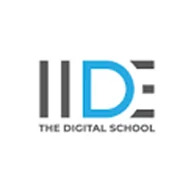
2. IIDE – the digital school: Known for its industry-aligned syllabus and experienced faculty, IIDE stands out for its focus on practical learning, ensuring students are job-ready.

3. DMTI is another well-known digital marketing course in Bandra. DMTI SOFTPRO was established in 2009. They provide a range of courses, including both online and classroom training. They have trained more than 29,729+ students in digital marketing.

4. upGrad is an online higher education platform providing rigorous industry-relevant programs designed and delivered in collaboration with world-class faculty and industry. Merging the latest technology, pedagogy, and services, upGrad is creating an immersive learning experience – anytime and anywhere.

5. Compufield is also one of the best digital marketing training institutes in Mumbai. It offers customized learning solutions to students, working professionals, and entrepreneurs. The Digital Marketing Training program is designed keeping in mind the latest industry trends and techniques.
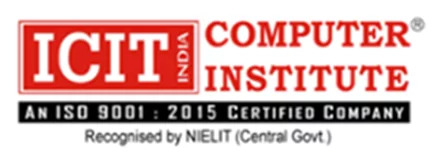
6. ICIT Computer Institute is one of the leading software training companies in India, offering comprehensive IT courses and cutting-edge training programs to IT aspirants [students & individuals], working professionals, corporates, institutions and government entities.

7. EduPristine is one of India’s leading training providers in Analytics, Accounting, Finance, Healthcare, and Marketing. Founded in 2008, EduPristine has a strong online platform and network of classrooms across India and caters to self-paced learning and online learning, in addition to classroom learning.

8. IIM Skills is another institute providing digital marketing courses in Bandra that provides online courses in different digital domains.
They provided real-time projects to ensure that they became well-trained for the digital industry. The institute offers a comprehensive course in digital marketing

9. Digital Vidya- The Digital Marketing Online Course at Digital Vidya offers a valuable learning experience through its hands-on assignments. These assignments are divided into module and case study tasks, which make the course more practical and engaging.
10. IDCM is India’s top-ranked vocational Training Institute, skilling 2 Lakh+ students annually. This course is designed for both freshers and working professionals who want to excel in their digital marketing careers. It is a classroom-based training program.
Exploring the Digital Marketing Course Fees in Mumbai:

Understanding the financial aspect is crucial. The digital marketing course fees in Mumbai vary across institutes. However, institutes like AADME offer value-driven courses without compromising quality.
Finding the Best Digital Marketing Institute in Mumbai with Placement:

Securing a placement after completing a course is a priority for many. Institutes like DMTI and AADME boast excellent placement records, forging lucrative career paths for their graduates.
Unveiling the Best Institute for Digital Marketing Course in Mumbai:
While each institute has its unique offerings, the 'best' institute depends on individual preferences. Factors like curriculum, faculty, industry connections, and alumni success stories play pivotal roles.
Empowering Your Digital Marketing Journey:

Now that you're equipped with insights into the top digital marketing courses in Bandra, Mumbai, it's time to leap! Choosing the right course can transform your career trajectory in the digital sphere.
Ready to delve deeper into the world of digital marketing in Bandra, Mumbai?
Explore our comprehensive guide to choosing the best digital marketing courses in Bandra tailored to your needs!
#digital marketing#best digital marketing courses in Mumbai#digital marketing courses in Bandra#digital marketing course fees Mumbai#digital marketing classes in Mumbai#best digital marketing institute in Mumbai with placement#best digital marketing training institute in Mumbai#best institute for digital marketing course in Mumbai
2 notes
·
View notes
Text
How to Build a Taxi Booking App Like inDriver, OLA, and Uber Clone App
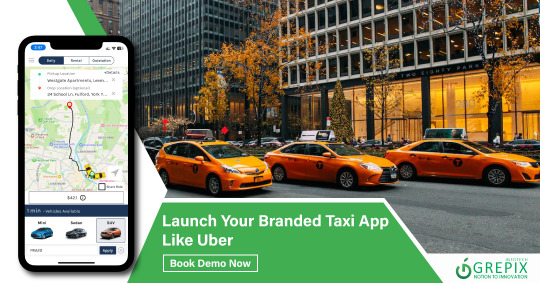
In today's fast-paced world, convenience is key when it comes to transportation. Taxi booking apps like inDriver, OLA, and Uber have revolutionized the way people get around. If you're looking to join the ride-hailing industry and create your own successful taxi booking app, you're in the right place. In this article, we'll guide you through the process step by step.
Understanding the Market
Before diving into app development, it's crucial to conduct thorough market research. This research will help you identify your target audience, understand their needs, and analyze your competitors. Here's how you can get started:
Market Analysis
Begin by researching the ride-hailing market in your target region. Identify key players, market trends, and potential gaps in services.
Target Audience
Determine your app's target audience. Are you catering to everyday commuters, tourists, or a specific niche? Understanding your users' preferences is essential.
Building the App
Now that you have a clear understanding of the market, it's time to start building your taxi booking app. This process involves several steps:
Feature List
Create a detailed list of features your app will offer. This should include user registration, driver profiles, GPS tracking, payment processing, and more.
Technology Stack
Choose the right technology stack for your app. Consider whether you want to build a native app for iOS and Android or opt for a cross-platform solution.
Design and User Experience
Invest in an intuitive and user-friendly design. The app's interface should be easy to navigate for both passengers and drivers.
Development Team
Assemble a skilled development team or hire a reputable app development company to bring your vision to life.
Testing and Quality Assurance
Thoroughly test the app for bugs, glitches, and security vulnerabilities. Ensure it functions seamlessly before launch.
Deployment
Release your app on app stores like Google Play Store and Apple App Store. Optimize your app listing with relevant keywords and appealing visuals.
Legal and Regulatory Considerations
Compliance with local regulations is essential in the ride-hailing industry. Be sure to:
Obtain Necessary Permits
Check with local authorities to understand the permits and licenses required to operate a taxi booking service.
Data Privacy
Implement robust data privacy measures to protect user information and comply with data protection laws.
Marketing and Promotion
Once your app is live, you'll need to market it effectively to attract users:
Digital Marketing
Utilize digital marketing strategies like search engine optimization (SEO), social media marketing, and online advertising to reach a wider audience.
Incentives and Referral Programs
Encourage users to refer friends and family by offering incentives and referral bonuses.
Scaling and Expansion
As your app gains popularity, consider expanding your services:
Geographic Expansion
Explore opportunities to launch your app in neighboring cities or countries.
Additional Services
Introduce additional services such as food delivery, package delivery, or carpooling to diversify your offerings.
Conclusion
Building a taxi booking app like inDriver, OLA, and Uber requires careful planning, a dedicated team, and a commitment to delivering a top-notch user experience. By following the steps outlined in this article, you can embark on your journey to creating a successful taxi booking app.
FAQs
How much does it cost to develop a taxi booking app?
The cost of app development can vary significantly depending on factors like features, complexity, and the development team's rates. It's best to get a personalized quote from app developers.
Is it essential to have a mobile app for both iOS and Android?
While having apps for both platforms is ideal for reaching a broader audience, you can start with one platform and expand later based on user demand.
What is the key to attracting drivers to my platform?
Offer competitive commissions, a user-friendly driver app, and efficient payment processing to attract and retain drivers.
How can I ensure passenger safety in my app?
Implement background checks for drivers, allow users to share ride details with friends, and incorporate a ratings and reviews system for drivers.
What are some emerging trends in the ride-hailing industry?
Some emerging trends include electric and autonomous vehicles, eco-friendly options, and improved AI for better route optimization and user experience.
4 notes
·
View notes
Text
The Latest Trends And Technologies In E-Commerce Website Development
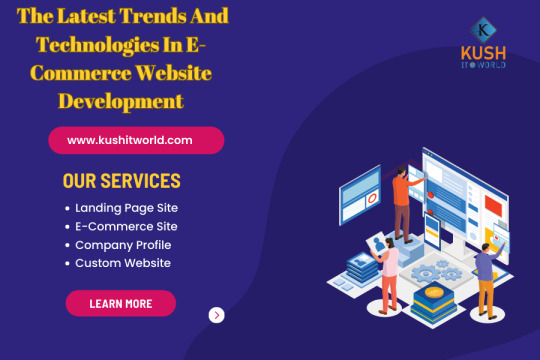
E-commerce Development Trends: Explore the latest trends and technologies in e-commerce website development, including payment gateways, product recommendations, and checkout optimizations.
The world of e-commerce is continuously evolving, and staying ahead of the curve is essential for businesses looking to succeed in the competitive online marketplace. As technology advances and consumer preferences shift, e-commerce website development must adapt to meet changing needs. In this article, we will explore the latest trends and technologies in e-commerce website development, including advancements in payment gateways, product recommendations, and checkout optimizations.
1. Advanced Payment Gateways
Payment gateways are the backbone of e-commerce, enabling secure and convenient online transactions. Recent developments in payment gateways have made the payment process smoother, faster, and more secure.
Digital Wallets: Integrating digital wallets like Apple Pay, Google Pay, and Samsung Pay offers users a convenient and secure way to make purchases, reducing cart abandonment rates.
Cryptocurrency Payments: Accepting cryptocurrencies like Bitcoin and Ethereum can open up new markets and cater to tech-savvy customers interested in digital assets.
One-Click Checkout: Simplify the checkout process with one-click checkout options, reducing the number of steps required to complete a purchase.
2. Personalized Product Recommendations
One-size-fits-all approaches to product recommendations are a thing of the past. Today’s consumers expect personalized shopping experiences. E-commerce websites are leveraging advanced technologies to provide tailored product recommendations.
Machine Learning Algorithms: Machine learning algorithms analyze user behavior and preferences to make accurate product recommendations. These algorithms continuously learn and adapt to deliver the most relevant suggestions.
AI-Powered Chatbots: Chatbots can assist users in finding products and make recommendations based on individual preferences. These chatbots offer real-time interactions and enhance the shopping experience.
Personalized Email Marketing: E-commerce websites are utilizing customer data to send personalized email recommendations, leading to higher engagement and conversion rates.
3. Augmented Reality (AR) and Virtual Reality (VR)
AR and VR technologies are making inroads into e-commerce, transforming how consumers interact with products online.
Virtual Try-On: In the fashion and beauty industry, virtual try-on solutions allow users to “try on” clothing, accessories, and makeup virtually, enhancing confidence in their purchase decisions.
360-Degree Product Views: Providing interactive 360-degree product views allows customers to examine products from all angles, improving their understanding of the product’s details.
Virtual Showrooms: VR-enabled virtual showrooms offer immersive shopping experiences, allowing customers to explore and interact with products in a virtual environment.
4. Progressive Web Apps (PWAs)
Progressive Web Apps are hybrid web applications that combine the best of web and mobile apps. They offer fast loading times, offline accessibility, and enhanced user experiences.
Improved Performance: PWAs load quickly and efficiently, reducing bounce rates and improving user engagement.
Offline Access: Users can access PWAs even when they have no internet connection, making them valuable in regions with unreliable connectivity.
Push Notifications: PWAs can send push notifications to users, re-engaging them and promoting new products or offers.
5. Voice Commerce
Voice commerce, also known as v-commerce, is on the rise. With the proliferation of voice-activated devices like Amazon Echo and Google Home, e-commerce websites are adapting to voice search and shopping.
Voice Search Optimization: E-commerce websites are optimizing their content and product descriptions for voice search to ensure that products are discoverable through voice queries.
Voice-Assisted Shopping: Users can add items to their shopping carts, place orders, and track deliveries using voice commands, simplifying the shopping experience.
6. Checkout Optimizations
The checkout process is a critical area for e-commerce website improvement. Reducing cart abandonment rates and streamlining the checkout process is a top priority.
Guest Checkout: Offering guest checkout options reduces friction for first-time shoppers who may be hesitant to create an account.
Multiple Payment Options: Providing a variety of payment options, including credit cards, digital wallets, and Buy Now, Pay Later solutions, caters to diverse customer preferences.
Abandoned Cart Recovery: Implementing abandoned cart recovery strategies, such as sending reminder emails or offering discounts, can win back potential customers.
Conclusion
As the e-commerce landscape continues to evolve, businesses must adapt to meet the ever-changing needs and preferences of online shoppers. Embracing these e-commerce development trends and technologies can provide a competitive edge, enhance user experiences, and drive growth in the digital marketplace. By staying up-to-date with the latest advancements, businesses can create successful and future-proof e-commerce websites that cater to the demands of today’s tech-savvy consumers.
Source:
#kushitworld#india#saharanpur#itcompany#seo#seo services#webdevelopment#digital marketing#websitedesigning
3 notes
·
View notes
Text
By: Claire Lehmann
Published: Jul 7, 2023
In medieval times, it was common practice for the wealthy to buy indulgences from the church to atone for their sins. These payments, the church assured, meant the person paying would not remain in purgatory for too long and would later ascend into heaven.
A wealthy person could even buy indulgences for their family members or ancestors who were long dead. Today we think of ourselves as far more enlightened than our medieval forebears. We secular folk would never pay a class of clerics large sums of money to atone for our sins. Or would we?
In recent years, billions of dollars have flowed into investment funds that market themselves as providing “environmental, social and governance” impacts. In Australia, industry super funds lead this trend, with money pouring into funds that then invest in companies that promote green, social justice, equity, diversity and inclusion causes.
The basic idea behind ESG, which has been promoted by organisations such as the World Economic Forum, is that one can make a profit and “do good” at the same time. Investors argue they can contribute to a net-zero future while making solid returns, or contribute to social justice alongside their fiduciary duty.
Rating agencies and research firms issue ESG “scores” to companies that are then used by bodies who advise institutional and retail investors which organisations they should invest in. Because ESG has no standardised metrics or even standardised definitions, such scores can be massaged by those companies that have enough money to play the game.
An entire industry of consulting agencies and non-profits exists today to implement cosmetic changes within companies to boost their ESG scores. Such cosmetic changes may include sponsoring a float at the Gay and Lesbian Mardi Gras or offering paid leave for staff who wish to change their gender.
As I commented in these pages last year, “gender affirmation leave” is offered by our two biggest supermarkets, Coles and Woolworths, and contributes to these companies earning “gold- and platinum-tier” status by the Australian Workplace Equality Index – despite the fact both companies are simultaneously implicated in wage theft scandals.
Sometimes called “wokewashing”, the practice of buying virtue through ESG allows corporate entities to deflect attention away from their PR embarrassments, like Henry VIII’s Indulgences allowed him to go on indulging.
Such practices are called wokewashing because these changes usually do not go deep enough to really cause change within a large organisation. By sheer virtue of their size, our largest corporations often make mistakes that only a complete overhaul of management practices could possibly address.
Take BHP, for example. The biggest company in Australia, and largest mining company in the world, is now embroiled in one of the biggest wage theft scandals in history. Accused of underpaying 28,500 workers $430m in wages for deducting public holidays from leave entitlements, BHP is now supporting the Yes vote in the voice referendum and has pledged a $2m donation to the campaign. This pledge is likely to boost its ESG score, but whether it satisfies the workers who have been underpaid is yet to be seen.
It is not just the mining industry that seeks ESG redemption. The banking industry wants to buy its way into heaven as well. Following on the heels of the disastrous royal commission into the sector, the Big Four are all doubling down on ESG. NAB faced criminal charges in 2021 for failing to pay casual employees long-service leave entitlements, but this is offset by its sponsorship of Midsumma – Melbourne’s queer arts and cultural festival. Last year ANZ was fined $25m for misleading consumer practices, but it also announced it was offering its staff paid leave for a sex change.
Commonwealth Bank has been in hot water in recent years for breaching money-laundering laws and Westpac was required to pay a $1.3bn fine after 250 customers made transfers that were linked to child exploitation. Both organisations are atoning for these sins by campaigning for the Yes vote.
Almost every large corporation that has signed on to the Yes campaign for the voice referendum is embroiled in some kind of scandal that involves their core business. Whether Coles is underpaying its staff, or Rio Tinto is dealing with dozens of accusations of sexual harassment, each company has significant work to do internally.
And this is why ESG is so popular among our corporate class. Symbolic gestures that can be outsourced to consultants and NGOs are an easy box-ticking exercise. Systemic changes to management habits, or making sure business practices are fair, is much more costly and time-consuming than simply waving a rainbow flag.
In the medieval period, wealthy elites would pay indulgences in order to curry favour with the church because the institution was incredibly powerful.
It is not surprising then that our biggest corporations are pledging their support for ESG goals that are also supported by the government, unions, the majority of our media, academia and non-profit sectors.
While commitment to ESG is not necessarily a sign of true moral fibre, if it can assist in washing away the stain of sin, then every dollar pledged will be money well spent.
==
Whenever a large corporation pledges its commitment to some movement or ideology, especially those that are unrelated to their actual business, you should assume that it's hiding something.
The more controversial the movement or ideology, the bigger the scandal they're trying to distract attention from.
For reference, the "Voice to Parliament" is a referendum to embed in the Australian constitution a vaguely defined independent body with unknown powers, unclear authority and unidentified influence to be a whisper in the ear of the Australian political system, supposedly representing all indigenous (Aboriginal) Australians. In essence, it functions as a form of "reparations."
When it's rejected, as current polling indicates it massively will be, as with Affirmative Action, citizens will be scolded by the supporters for their "racism," and the country will be told it's irredeemably racist. Rather than recognizing the diverse objections to the initiative: the lack of transparency of what the body is or does; progressives who insist it doesn't go far enough (e.g. a desire to literally "hand back" the land); Aboriginal Australians themselves who are concerned about establishing a "separate but equal" system; importing Critical Race Theory ideas from the US to racially divide the nation; the rather racist notion itself that any single "voice" could represent all indigenous people, ignoring that their viewpoints are as diverse as everyone else's; and the very simple answer of "I don't like this particular solution."
But while all of that is going on, the companies will be looking for their next diversion.
#Claire Lehmann#wokewashing#woke washing#voice referendum#voice to parliament#referendum#wokescreen#indigenous voice to parliament
6 notes
·
View notes
Text
10 Promising Scopes of Digital Marketing in India are Revealed
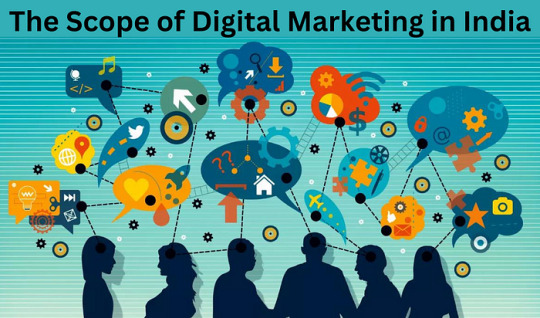
1. The Digital Revolution
India’s digital revolution is in full swing. Thanks to affordable smartphones and high-speed internet becoming widely available, millions of Indians are now online. This massive online audience is a goldmine for digital marketers.
2. Thriving E-commerce Scene
Online shopping has exploded in India. Platforms like Flipkart, Amazon, and others have revolutionized how we shop. Digital marketers are crucial in attracting customers and driving sales for these e-commerce giants.
3. Booming Start-up Culture
India’s start-up culture is thriving, with new companies emerging in various sectors. Digital marketing is vital for start-ups to gain visibility, acquire customers, and secure funding.
4. Digital Payments and Fintech
Digital payment platforms like Paytm, PhonePe, and Google Pay have become an integral part of India’s financial landscape. Digital marketing plays a key role in promoting these platforms and encouraging people to use them.
5. Content is King
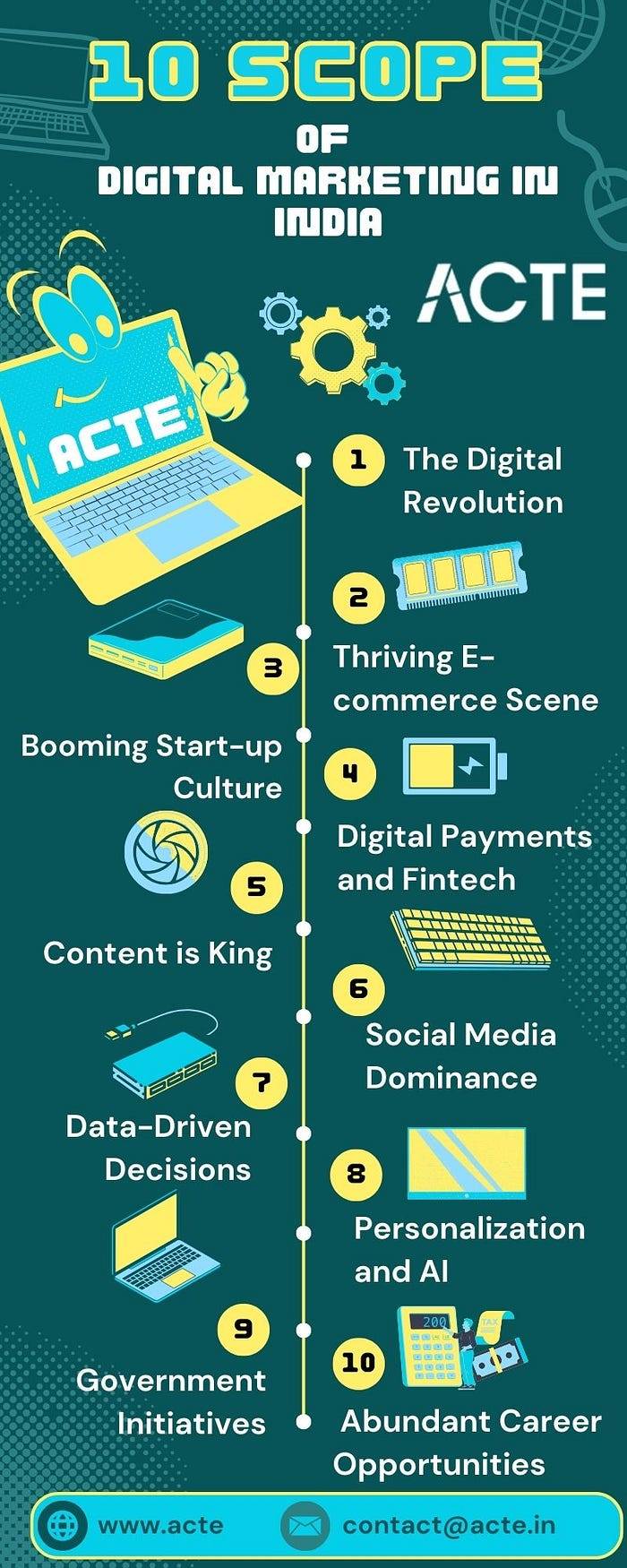
6. Social Media Dominance
Social media platforms like Facebook, Instagram, Twitter, and LinkedIn are where Indians spend a lot of their online time. Digital marketers leverage these platforms to create compelling campaigns that resonate with diverse audiences.
7. Data-Driven Decisions
Digital marketing relies heavily on data. Marketers use data analytics to understand consumer behavior, track campaign performance, and spot market trends. The demand for professionals who can work with data is on the rise.
8. Personalization and AI
Artificial intelligence (AI) and machine learning are changing the game in digital marketing. Personalized marketing campaigns that cater to individual preferences are becoming the norm. Marketers who embrace AI have a competitive advantage.
9. Government Initiatives
Government programs like Digital India and Skill India are boosting digital literacy. This aligns with the growing need for digital marketing experts skilled in SEO, SEM, email marketing, and more.
10. Abundant Career Opportunities
Digital marketing offers a wide range of career options. Whether you’re into content creation, social media management, SEO, SEM, or data analysis, there’s a niche for everyone. Consider ACTE Technologies, a top institute that provides comprehensive digital marketing courses, if you want to start your digital marketing path with experienced assistance. Their knowledgeable teachers can provide you with the skills and information you need to succeed in the field of digital marketing.
In summary, digital marketing in India is flourishing and full of potential. As more businesses, start-ups, and individuals move their activities online, the demand for digital marketing expertise continues to grow. For those interested in an exciting and rewarding career, digital marketing is a field brimming with opportunities in today’s digital India.
2 notes
·
View notes
Text
How eCommerce mobile app development is beneficial for small business?
eCommerce mobile app development can offer several significant benefits to small businesses. Here are some key advantages:
Increased Visibility and Accessibility: Mobile apps provide a dedicated platform for your business, making it easier for customers to find and access your products or services. Customers can shop conveniently from their smartphones, which is especially crucial as mobile usage continues to rise.
Enhanced User Experience: Mobile apps can be designed to offer a user-friendly and tailored experience. You can implement features like personalized recommendations, easy navigation, and one-click purchasing, improving the overall shopping experience.
Customer Engagement: Mobile apps allow you to engage with customers through push notifications, promotions, and loyalty programs. This direct communication channel can help you keep customers informed about special offers, new products, and updates.
Improved Brand Loyalty: A well-designed and user-friendly app can create a strong connection between your brand and customers. It can also encourage repeat business by offering loyalty rewards and incentives.
Data Collection and Analysis: Mobile apps enable you to gather valuable data about customer behavior, preferences, and buying patterns. This data can be used to refine your marketing strategies and tailor your offerings to customer needs.
Competitive Advantage: Having a mobile app can set your small business apart from competitors that rely solely on websites. It shows a commitment to staying current with technology trends and meeting customers where they spend much of their online time.
Simplified Checkout Process: Mobile apps can offer a streamlined and secure checkout process, reducing cart abandonment rates. Features like saved payment information and easy order tracking can encourage customers to complete their purchases.
Offline Accessibility: Some mobile apps can function in offline mode, allowing users to browse products and even make purchases without an internet connection. This is especially valuable for businesses in areas with inconsistent connectivity.
Feedback and Reviews: Mobile apps can facilitate customer feedback and reviews, which can boost your credibility and help potential customers make informed decisions.
Cost-Effective Marketing: Mobile apps provide a cost-effective platform for marketing your products or services. You can run targeted ad campaigns within the app, reducing the need for expensive external advertising.
Scalability: As your business grows, a mobile app can easily scale to accommodate more products, customers, and features without major structural changes.
Global Reach: A mobile app can help your small business reach a global audience, expanding your customer base beyond local or regional boundaries.
While eCommerce mobile app development offers numerous benefits, it's essential to carefully plan and execute your app strategy to ensure it aligns with your business goals and customer needs. Additionally, staying responsive to user feedback and continually improving your app is key to long-term success.
#cedcommerce#ecommerce#ecommercebusiness#ecommercestore#woocommerce#woo#shopify#shopifyseller#ecommercewebsite#business growth#ecommercesolutions
2 notes
·
View notes
Text
How to Choose the Right Niche for Affiliate Marketing: A Comprehensive Guide
Introduction:

Affiliate marketing has become a popular avenue for generating passive income. By promoting products or services and earning a commission for every sale made through your referral, you can establish a profitable online business. However, one crucial factor that determines your success in this field is choosing the right niche. In this blog post, we will delve into the step-by-step process of selecting the perfect niche for your affiliate marketing endeavors, ensuring maximum profitability and long-term sustainability.
I. Understanding the Concept of Affiliate Marketing
Affiliate marketing is a performance-based marketing model where individuals or businesses promote products or services in exchange for a commission. To embark on this journey, it's essential to comprehend the basics of affiliate marketing, including the role of affiliate networks and how they connect advertisers and affiliates.
II. Conducting Market Research
Thorough market research is the foundation of successful niche selection. By conducting comprehensive research, you can identify popular niches and emerging trends. Utilize keyword research tools to explore potential niches and evaluate competition and profitability. This step will help you discover lucrative opportunities within your desired market.
III. Identifying Your Interests and Passions
While profitability is a crucial aspect, your personal interest and passion for the niche play a significant role in your success as an affiliate marketer. Brainstorm and create a list of your hobbies and passions, then evaluate their marketability and profit potential. Selecting a niche that aligns with your interests will not only make your work enjoyable but also improve your understanding of the target audience.
IV. Assessing Target Audience and Demographics
Understanding your target audience is vital for niche selection. Define the characteristics and demographics of your potential customers. Conduct research to identify their needs, desires, and pain points. By aligning your niche with the interests and preferences of your target audience, you increase the chances of capturing their attention and driving conversions.
V. Evaluating Affiliate Programs and Products
Research reputable affiliate programs and networks that cater to your chosen niche. Analyze commission structures, payment methods, and terms of service. Additionally, evaluate the quality, relevance, and popularity of the affiliate products you intend to promote. Look for opportunities that offer recurring commissions or upselling potential, as these can significantly boost your earnings.
VI. Testing and Validating Your Chosen Niche
To ensure the viability of your chosen niche, create a small-scale website or landing page to test audience engagement. Conduct pilot campaigns to measure response rates and analyze data. Based on the performance, make necessary adjustments to your niche selection. This iterative process will help you validate your niche before committing extensive resources.
VII. Ensuring Long-Term Sustainability
Consider the scalability and growth potential of your chosen niche. Will it withstand market changes and trends in the long run? To future-proof your affiliate marketing business, explore opportunities to expand into related sub-niches or complementary niches. Diversifying your offerings can help maintain your income streams and adapt to evolving market dynamics.
VIII. Creating Quality Content and Establishing Authority
One of the key elements of successful affiliate marketing is providing value through quality content. Develop a content strategy that attracts and engages your target audience. By consistently producing valuable content, you establish yourself as an authority in your niche, gaining trust and credibility among your followers.
IX. Promoting Your Affiliate Offers
Select the appropriate marketing channels to reach your target audience effectively. Implement search engine optimization (SEO) techniques to drive organic traffic to your website or blog. Leverage the power of social media, email marketing, and paid advertising strategies to promote your affiliate offers and maximize your reach.
Conclusion:
Do you want to make money from Affiliate marketing or want to take your affiliate marketing to the next level? Do you want the Financial Freedom you deserve? Do you want the ultimate key to Affiliate Marketing?
If 'yes'. Here You are, you must invest in Freedom Asselator which is one of the best course on Affiliate Marketing for Both Beginners and someone who wants to take their Affiliate marketing to the Next Level.
Freedom Accelerator to gain expert insights on choosing the right niche for affiliate marketing. With its comprehensive modules and actionable strategies, this course can empower you to make informed decisions, maximize profitability, and achieve the freedom you desire in your affiliate marketing journey.
Freedom Accelerator, designed specifically to solve your problems. With its comprehensive modules and proven strategies, this course will guide you through each and every Process helping you overcome the challenges and uncertainty. Unlock the potential for maximum profitability and achieve the freedom you've been longing for in your affiliate marketing journey.
Hurry up, and Accomplish Your Dreams With Freedom Asselator.
#make money online for beginners#affiliate marketing tips#affiliate#affiliate marketing#digital marketing#make money from home#online business
3 notes
·
View notes